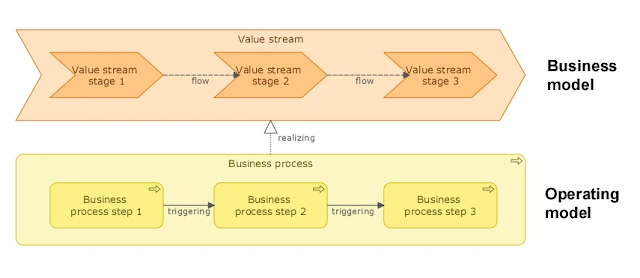Let’s talk about business streams and value processes.
Wait, say what? Don’t you mean value streams and business processes?
Yes, in fact I do.
But to emphasize that both concepts are very close to each other, I have mixed them up (like most people who work with these architectural concepts). Of course, this is unnecessary, because both concepts differ from each other in more than one way.
A little history
The concept of value stream originated sometime between 1940 and 1950. It was developed at the time to understand the information and material flow through a production process.
Later, in the 1990s, the value stream gained more recognition with the introduction of Lean Manufacturing. This involved a concept of removing waste and improving the efficiency of business processes. Lean Manufacturing is based on the idea that any activity that does not add value to the customer is considered waste and should be eliminated. The focus is on streamlining the production process and optimizing every step of the value stream, getting rid of waste along the way.
Today, the value stream concept is widely used.
Dare to be different
Value streams and business processes are related concepts used in business architecture, but they have different perspectives and scopes.
A value stream
- Refers to the set of activities that add value to a product or service from the perspective of the customer. A business process is a set of related activities that work together to achieve a specific goal or objective within an organization.
- Focuses on the entire value chain, from the initial customer request to the delivery of the product or service. A business process may focus on a specific aspect of the value chain, such as procurement, production, or customer service.
- Is customer-oriented, with the goal of meeting customer needs and expectations. A business process may be more internally focused, with the goal of improving efficiency, reducing costs, or increasing productivity within the organization.
- Targets the business model, whereas a business process targets the operating model.

In summary, value streams refer to the series of activities or steps that an organization takes to create, deliver, and capture value for its customers. A value stream encompasses the entire end-to-end process, including all the activities, resources, and information flow involved in creating and delivering a product or service to a customer.
Business processes are the specific set of activities or tasks that an organization uses to achieve a particular business objective. Business processes are typically narrower in scope and focus on the steps and activities required to accomplish a specific goal or outcome. They can be part of a larger value stream or can span across multiple value streams.
One source, multiple truths
Having read the book Business Architecture – Collecting, Connecting, and Correcting the Dots by Roger Burlton, I noticed the following passages.
I fell comfortable treating the processs architecture stack at the top as a value chain […] that contains value streams […], these are called levels of process architecture by process architects. These are the same things.
Roger Burlton, Business Architecture – Collecting, Connecting, and Correcting the Dots, p. 187
[…] some business architects use the name value stream rather than business process. This is simply a semantic issue, and there is no difference in content or intention if well designed.
Roger Burlton, Business Architecture – Collecting, Connecting, and Correcting the Dots, p. 278
Author of the book Strategy to Reality, Whynde Kuehn, mentions the following about value streams and business processes.
Ideally both value streams and capabilities will be created as part of an organization’s baseline […]. Value streams help us see the business in motion, but it’s capabilities (and the people, process, and technology they employ) that enable them.
Whynde Kuehn, Strategy to Reality, p. 52
Business architecture value streams make provide the ideal framework for organizing […] a rule-based routing map. Furthermore, like process maps, rule-based routing maps describe the additional detail that occurs within a value stream stage. Rule-based routing maps are part of the operating model.
Whynde Kuehn, Strategy to Reality, p. 153
The aforementioned quotes underline the confusion that still exists when it comes to the aforementioned elements. What makes this even more interesting is that Roger Burlton contributed to the BIZBOK® Guide and Whynde Kuehn’s book draws upon its key concepts. Even though the same source is used, it apparently creates different views of value streams and business processes.
One of the whitepapers found on the Business Architecture Guild website is titled Similar, yet different: Value streams and business processes: the business architecture perspective. This whitepaper describes the similarity between the two elements and also notes the differences.
At this higher level of representation, many value streams and business process models will seem similar in concept and name. But sometimes, the names of the value stream structures differ from the conceptual processes due to the BIZBOK® Guide principles which require that they are fully stakeholder value-oriented with the appropriate stage gates.
For the sake of consistency, the authors are advocating that business process maps at the value level follow the same naming convention if possible and are framed by the same event structure as the value stream and its stages since both are striving for the same results.
Whitepaper Similar, yet different: Value streams and business processes: the business architecture perspective, p. 4/5
Basically, the whitepaper is saying that the value stream concept is leading when it comes to describing value creation for stakeholders. Not business processes. Not even high-level ones.
The whitepaper concludes, however, that both views (high-level business processes can be value streams and value streams are something other that high-level business processes) have a grain of truth. Seeking cooperation between the elements strengthens both. To this I can agree.
Looking back at the comparison I made earlier between value streams and business processes, I believe it’s safe to say that a business process differs from a value stream on a number of fronts to not lump them together.
A business process can be can be part of a larger value stream or can span across multiple value streams, but it cannot be the other way around; a business process cannot be a high-level version of a value stream. Not even if it is well designed.
Looking ahead
Value streams are a very powerful tool if used correctly. They are an insightful means to show how an organisation creates value for its customers. Business processes are also indispensable, albeit at a very different level.
I believe that value streams will continue to evolve and gain ground over time to eventually become widely accepted as a valuable (pun intended) and stand-alone element within Enterprise (and Business) Architecture.
Note: I am not saying that either of the aforementioned authors are wrong about their views on value streams and business processes. I just pointed out the ongoing discussion about the two concepts.







Leave a Reply